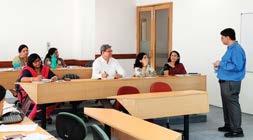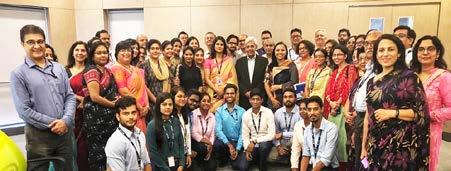
8 minute read
Faculty Development Programs
IILM, committed to excellence in Management education, believes in enhancing the academic and intellectual environment by providing faculty members with ample opportunities to learn from some of the renowned academicians of the country’s premier institutions. In this endeavour IILM organized several Faculty Development Programs this year to elevate the quality of teaching skills required in contemporary management education in India. Global Economic & Financial System and Policy Issues in International Trade Professor Sanket Mohapatra, Professor, IIM Ahmedabad Conducted at IILM Gurugram Campus, this FDP was attended by faculty members from all three campuses and some selected students. Session One The day long FDP started with its first session focusing on the evolution of Global Economy from the past to the present which covered the history of International Monetary System - from Gold standard mechanism to Bretton Woods/ IMF/IBRD/World bank to different phases of Quantitative Easing (QE) by US Fed Reserve and negative interest rates. Also discussion progressed towards establishment of exchange rate regimes, introduction of Euro and Global Financial Crisis and great recession across advance economies in 2008-09. Session Two In the second session, the case of USA–China Trade war was taken up where deliberations were made upon international trade, finance and development, dispute resolution under WTO, bilateral and preferential trading agreements. The discussion further headed towards growth of Global Value Chains (GVCs) in international trade,
Prof Mohapatra sharing his valuable thoughts with the participants technology and automation, global welfare gains from trade. The case discussion moved in the direction of various accusations imposed by US on China mainly undervaluing its exchange rate, IP theft and technology transfer, jobs stealing, lack of reciprocity of China in providing similar access to US imports. Session Three In the third and last session, the case of Ethiopia: An Emerging Market Opportunity (HBS Publishing) was taken up. Through the case, thoughts were held on foreign investment flows towards emerging and frontier markets like India and Ethiopia. Assessing macro and micro risks and opportunities in foreign markets play a very crucial role which includes analysis of various factors relevant for foreign investments – political environment, market opportunity and access, industrial policy, ease of doing business, infrastructure, human resources, enforcement of intellectual property rights and competitive position. The case focused on three foreign companies who want to invest in Ethiopia. Four different market entry strategies – import through local agent, licensing, joint venture and wholly owned subsidiary were discussed and solutions sought in the light of the case based data. The FDP concluded with a take home on not just the subject content but also reinforcement of the tried and tested teaching pedagogy of case based class discussion and participation. Largely, it was a great learning experience. The participants gained insight into the global economic and financial system, understanding of emerging and frontier markets, dollar’s dominance in global finance, relevance of trading agreements and factors inducing foreign investments. Managing in VUCA World Professor Amit Karna, Professor, IIM Ahmedabad Session One Professor Karna started with the discussion on why is it important to understand the VUCA - Volatile, Uncertain, Complex and Ambiguous world. The session on Technology and Strategy Making proceeded with considering the case study of Kodak and the Digital Revolution. The case examined Kodak’s transition from traditional photography to digital imaging. He emphasized on three most important elements in business– Value, Price and
Advertisement
An intriguing session on Policy Issues in International Trade

Cost. During the session, Professor Karna proposed that strategy is all about making choices and how by being differentiated a business can create value for its customers. He argued about four trajectories of Industry change, i.e., Radical/ Creative/Intermediating/Progressive in the light of core activities and core assets along with Cognitive Inertia to change. He explained how investments in innovation are more likely to pay off if these pathways are taken into account. Session Two The next session on Disruptive Innovations started with a discussion on the case study of Netflix Vs Blockbuster Inc. The considerations and learnings reflected on what are Business Models and how are they built. A Business Model starts with a value proposition - a product or service that aims to provide convenience and affordability to customer. A business model rests on value proposition, resources, processes and profit formula. Innovations can be of four types - Radical, Incremental, Architectural and Disruptive. Incumbents who have blind spots or who ignore weak signals are likely to be disrupted. Disruptive Innovation impacts the industry as they change the way of doing business with the existing customer. Architectural Innovations recombine the existing technologies into new markets. Disruptive Innovations should first be treated as threat and later as an opportunity during business model development. Professor Karna also spoke about Design Thinking and its relevance in today’s world. He talked about five stages in the design thinking process – Empathize, Define, Ideate, Prototype and Test. Understanding these five stages of Design Thinking can enable us to apply the Design Thinking approaches so as to solve complex problems that occur around us in our companies and in our country. The FDP was attended by faculty members from all three campuses and some select students from Gurgaon campus and it was a great learning experience. The participants gained insight into how to manage businesses in VUCA world and how industries change; what are business models; how are they built and how investment in innovations pay back. Digital Learning and its adoption, with specific reference to Blended Learning Professor P C Narayan, IIM –Bangalore An FDP was organised on Digital learning and its adoption by at IILM Greater Noida campus. The key highlight of the session was to deliver what the students need rather than what the faculty as a tutor knows. This was in continuation with the tradition of conducting faculty development programme at IILM in collaboration with IIMs. Professor Narayan was invited to share his experience with blended learning format and digital platform in classroom teaching. He is associated with IIM, Bangalore and edX, which is an open online course provider in the area of

finance and accounting. He has a rich experience of over three decades with a unique combination of academics and industry specialising in blended classrooms with the help of online courses. During the session, Prof Narayan highlighted the relevance of blended and flip classrooms vis-a-vis usage of technology as a powerful tool in making class more meaningful for students. He emphasized that students today are vastly different from when the faculty were in their shoes. Most of the faculty were brought up on the age-old tradition of lecture, practice, and assessment-lather, rinse, repeat. Students today were also brought up in the same style but something is different. Something just isn’t working anymore. What do we do? We google it! We YouTube it! We even ask a forum that is knowledgeable on the subject. Why do we do this? Because we know it is the best way to learn in our own style, in our own time. Self-Directed Learning is the new learning. These can be accessed from home or anywhere you have access to the Internet, and are usually delivered through a Learning Management system (LMS). Online learning does not replace traditional learning; instead the two methods of learning are used together in a complementary way, to create a full and inclusive learning experience. Flipped Classroom learning is when you reverse the delivery method in traditional learning. The time in class is spent on working through the concepts being delivered with the guidance of an instructor. Complementary to all of this is an online platform where learners and instructors can discuss with one another. Blended Learning is a combination of online learning, and faceto-face learning. The online learning includes components like video games, podcasts, online reading material, and online assignments. Professor Narayan started his session with a news piece ‘Dual regulation of banks leads to fissure in the system’, followed by a discussion on how interest rates affect the economy. He made the session interactive by showing self-created videos on edX platform and related it to real life scenarios. Then a second news piece ‘RBI set to cut interest rate in August for the fourth time in a row’ was discussed as an extension of first topic. As faculty, he emphasized on effective learning that can strengthen efficiency and the overall concept of teaching and learning which can be helpful in connecting with the students better through blended learning. Professor Narayan also established a strong connect between Finance and Economics and how it impacts the growth and development globally and in India. The traditional model of learning has primarily revolved around a teacher-centred classroom where instructors focus on conveying information, assigning work, and leaving it to the students to master the material. Though effective for some, this type of instruction has forced students to be merely receptors of information, rather than participants in their own learning processes through active learning. Fortunately, as technology has increasingly grown and infiltrated our classrooms, a new learning model has emerged that moves away from a teacher-centred space, and onto a more collaborative, studentcentred learning environment, by way of a flipped classroom. The FDP emphasised to change the method of teaching with changing times and demands and was extremely useful for the faculty of IILM who were enthusiastic about using blended learning in their classrooms.

Professor PC Narayan, IIM –Bangalore, with the participants at the FDP on Blended Learning










